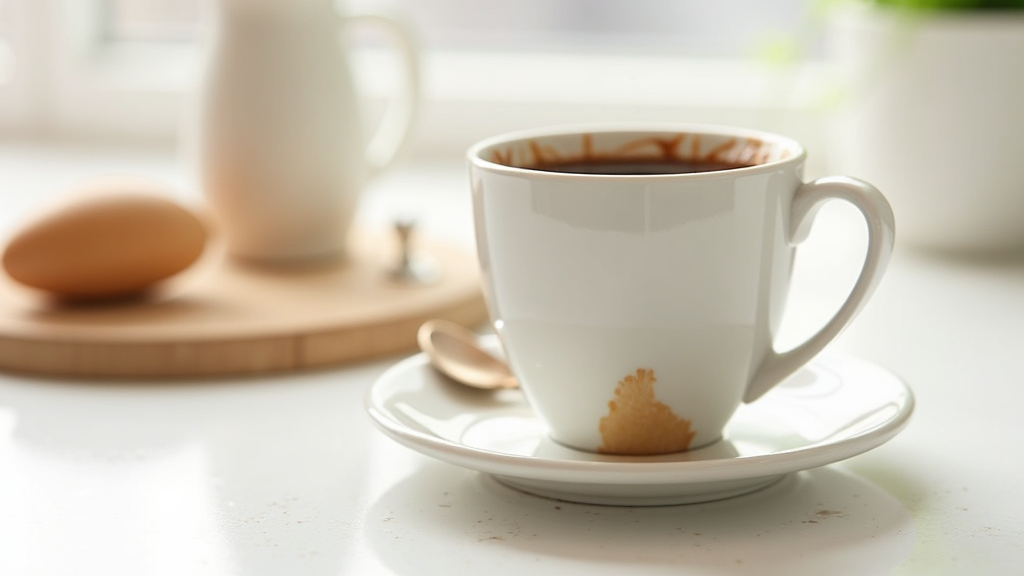Table of Contents
- The Ultimate Guide: How to Clean Coffee Stained Mugs Outline
- Understanding How to Clean Coffee Stained Mugs
- Key Components for Cleaning Coffee Stains
- Detailed Guide: Cleaning Your Coffee Stained Mugs
- Preventing Coffee Stains: Keeping Mugs Sparkling Clean
The Ultimate Guide: How to Clean Coffee Stained Mugs Outline

Why Cleaning Coffee Stained Mugs Outline Matters
Coffee stains in mugs are a universal problem for coffee lovers, impacting not only the appearance of your favorite mugs but also potentially affecting hygiene. It’s estimated that around 80% of regular coffee drinkers notice staining in their mugs within just one month of use. Keeping your mugs clean is important for aesthetic reasons, ensuring your drinkware looks presentable, and also for preventing the build-up of bacteria that can thrive in the porous surfaces of stained mugs.
The Science Behind Coffee Stains in Mugs Outline
Coffee staining is primarily caused by tannins, which are polyphenols naturally present in coffee beans. These compounds have a tendency to stick to surfaces and create a persistent discoloration. Historically, people relied on harsh abrasive cleaners to remove these stains. Nowadays, we have access to gentler, yet equally effective techniques. Recent advancements focus on eco-friendly and non-toxic cleaning solutions, ensuring you can keep your mugs sparkling without harming the environment or your health.
What You’ll Learn About Coffee Stains Removal Outline
In this guide, you’ll gain a deep understanding of the science behind coffee stains and why they’re so stubborn. We’ll provide you with step-by-step cleaning methods using common household items, making it easy to tackle stains with what you already have. Furthermore, you’ll learn preventive measures to minimize future staining, so you can enjoy your coffee without constantly battling unsightly marks.
Understanding How to Clean Coffee Stained Mugs
The Science Behind Coffee Mug Staining
**Expert Insight:** Effectively cleaning coffee-stained mugs requires understanding the dual nature of the stain: mineral deposits and organic compounds. Using a balanced approach with both acidic cleaners like vinegar to tackle mineral buildup and alkaline cleaners like baking soda to lift organic matter, followed by gentle abrasion, will yield the best results without damaging your mugs.
Coffee stains in mugs are primarily caused by tannins, natural plant compounds found in coffee beans. These tannins have a strong affinity for surfaces like ceramic and porcelain, leading to discoloration over time. Understanding the chemical properties of tannins is crucial for effectively removing these stubborn stains.
The Role of pH in Coffee Stain Removal
The acidity and alkalinity (pH levels) of cleaning agents play a significant role in breaking down coffee stains. Acidic cleaners like vinegar and lemon juice are effective against mineral deposits often found in coffee stains, while alkaline cleaners like baking soda help lift the organic compounds. Balancing pH is key to effective stain removal without damaging your mugs.
Balancing Abrasion and Surface Protection
Abrasion, or the use of friction, is often necessary to remove coffee stains. However, it’s essential to balance the effectiveness of abrasion with the risk of scratching the mug’s surface. Using abrasive cleaners and tools improperly can lead to permanent damage, so gentle yet effective methods are preferred.
Key Components for Cleaning Coffee Stains

Effective Cleaning Agents for Coffee Stains
Several cleaning agents are effective at removing coffee stains. Each has unique properties that make them suitable for different types of stains and mug materials:
- Baking Soda (Sodium Bicarbonate):A mildly abrasive, alkaline cleaner that can scrub away stains without harsh chemicals.
- Vinegar (Acetic Acid):An acidic cleaner that’s particularly effective against mineral deposits and hard water stains often found alongside coffee stains.
- Lemon Juice (Citric Acid):A natural acid that works well for breaking down coffee stains and leaving a fresh scent.
- Dish Soap:A surfactant that helps lift stains by reducing the surface tension between the stain and the mug.
- Denture Tablets:These contain enzymes and oxidizing agents that can dissolve coffee stains effectively.
- Hydrogen Peroxide (H2O2):An oxidizing agent that helps break down the molecular structure of stains, making them easier to remove.
Essential Tools for Cleaning Coffee Mugs
Having the right tools can make the process of cleaning coffee stained mugs much easier and more effective:
- Nylon Scrubber:Effective for scrubbing away stains without scratching delicate surfaces.
- Magic Eraser (Melamine Foam):A micro-abrasive tool that can lift stubborn stains with minimal effort.
- Soft Cloths (Microfiber):Gentle for wiping and polishing mugs after cleaning, preventing streaks and water spots.
- Sponges:Useful for general cleaning and applying cleaning solutions.
- Bottle Brush:Ideal for cleaning hard-to-reach areas, especially in mugs with narrow openings.
Detailed Guide: Cleaning Your Coffee Stained Mugs
Preparation Steps Before Cleaning Coffee Stained Mugs
Before diving into the cleaning process, ensure you have all the necessary materials and a suitable setup. Proper preparation will make the task more efficient and protect your mugs from potential damage.
- Required Materials:Baking Soda, White Vinegar, Lemon (Juice or Wedges), Dish Soap, Denture Tablets, Magic Eraser, Non-Scratch Scouring Pad, Table Salt, Hydrogen Peroxide, Filtered Water
- Initial Setup:Gather all materials in a well-lit area. Wear gloves if desired, especially when using lemon or bleach. Ensure proper ventilation when using strong cleaners like bleach.
- Important Considerations:Test cleaning methods on an inconspicuous area first, especially for delicate materials. Avoid using bleach on porous mugs due to potential absorption. Rinse thoroughly after each cleaning method to remove residue.
Step-by-Step Guide: Cleaning Methods for Coffee Stains
This section provides detailed instructions for various cleaning methods, each suited for different types of stains and mug materials. Follow these steps carefully to achieve the best results.
- Dishwasher Method:Place mugs in the dishwasher, ensuring they are dishwasher-safe. Use a standard dishwasher detergent. Turn off the heated dry cycle to prevent setting stains.
- Liquid Dish Soap:Mix 1 teaspoon of liquid dish soap with boiling water. Scrub the mug with a nylon scrubber. Rinse thoroughly with hot water. Ideal for stainless steel mugs.
- Baking Soda Paste:Mix 2 tablespoons of baking soda with 1 tablespoon of water to form a thick paste. Apply the paste to the stained areas. Scrub with a nylon scrubber for 1-2 minutes. Rinse and repeat if necessary.
- Magic Eraser:Wet the Magic Eraser with water. Gently scrub the stained areas with a back-and-forth motion. Rinse the mug thoroughly after use.
- Denture Tablets:Place 1 denture tablet in the mug. Fill the mug with cold water. Let it sit overnight (8-12 hours). Rinse thoroughly before use.
- Lemon Juice or Vinegar:Mix equal parts water and lemon juice or vinegar (e.g., 1/2 cup each). Add 1 tablespoon of table salt for extra abrasion (optional). Let the mixture sit for a few hours (2-3 hours). Scrub with a sponge or nylon scrubber. Rinse thoroughly.
- Scouring Pad:Use a commercial non-scratch scouring pad. Scrub the stained areas, rinsing frequently to monitor progress. Ensure the pH and abrasion levels are safe for the mug material.
- Lemon Wedges:Cut a lemon into wedges. Scrub the stained areas with the lemon wedge, optionally squeezing juice into the mug first. Rinse and wash the mug, repeat as needed.
- White Vinegar Soak:Pour vinegar into the mug, filling it to cover the stains. Let it soak for 10-20 minutes. Dump out the vinegar, scrub the area, and rinse.
- Salt and Ice:Add 2 tablespoons of salt and a handful of crushed ice to the mug. Cover with plastic wrap and shake vigorously for 1-2 minutes. Rinse and check the stain, repeat if necessary.
- Scouring Powder (e.g., Bar Keepers Friend):Mix a small amount of scouring powder with water to form a paste. Apply the paste to the stained area and scrub. Let it sit for 10-15 minutes, scrub again, and rinse thoroughly. Avoid overly abrasive materials to prevent damage.
- Hydrogen Peroxide and Baking Soda Paste for Stainless Steel:Make a paste with 1 tablespoon of hydrogen peroxide and 2 tablespoons of baking soda. Apply the paste to the stain. Allow it to sit for about 30 minutes before rinsing.
- Natural Cleaning Method (Lemon and Baking Soda):Rub a lemon wedge inside the mug, covering it with lemon juice. Pour enough baking soda to coat the inside of the mug. Let the mixture sit for 2 minutes. Scrub the inside of the mug with a slightly damp sponge or cloth using circular motions. Rinse thoroughly with water.
- Bleach Method:Pour bleach into the mug, swirling to cover all surfaces. Add hot water and let it sit for 10 to 15 minutes. If stains persist, use a brush to gently clean the mug. Wash with detergent or rinse multiple times to ensure all bleach is removed.
Advanced Techniques for Stubborn Coffee Mug Stains
For particularly stubborn stains that resist conventional methods, these advanced techniques can provide the extra cleaning power needed to restore your mugs to their original glory.
- Expert Tips:Address stains promptly to avoid deep setting. Regular washing helps minimize staining from tannins. Use soft brushes like bottle brushes for cleaning narrow mugs.
- Optimization Methods:Pre-soak mugs in hot water with a mild detergent before using other cleaning methods. Combine cleaning methods for stubborn stains (e.g., baking soda paste followed by vinegar soak).
- Troubleshooting:Persistent Stains: Repeat cleaning process or try a different method. Scratched Mugs: Use gentler cleaning methods and avoid abrasive scrubbers. Lingering Odors: Soak mugs in a solution of water and baking soda overnight.
Preventing Coffee Stains: Keeping Mugs Sparkling Clean

Rinse Mugs Immediately After Use to Prevent Staining
The simplest and most effective way to prevent coffee stains is to rinse your mug immediately after you finish your drink. This prevents the coffee residue from drying and hardening, making it much easier to clean later. Even a quick rinse with water can make a significant difference.
Regular Washing Prevents Stubborn Coffee Stain Buildup
Don’t let coffee mugs pile up in the sink! Regular washing, whether by hand or in the dishwasher, will prevent stubborn stains from forming. A quick scrub with dish soap and a sponge after each use is ideal.
Choosing Stain-Resistant Mug Materials: A Proactive Approach
Some materials are more prone to staining than others. Consider using mugs made from materials like glass or stainless steel, which are generally more stain-resistant than ceramic or plastic. While not completely stain-proof, they require less effort to keep clean.
Using a Gentle Abrasive Cleaner Weekly on Mugs
Even with regular rinsing and washing, some staining may still occur. Using a gentle abrasive cleaner, such as baking soda paste, once a week can help remove any buildup before it becomes too difficult to clean. Apply the paste, scrub gently, and rinse thoroughly.
Avoid Letting Coffee Sit for Extended Periods
The longer coffee sits in a mug, the more likely it is to stain. Avoid leaving coffee in your mug for extended periods, especially overnight. If you can’t rinse it immediately, at least empty the mug to prevent the coffee from drying and hardening.

